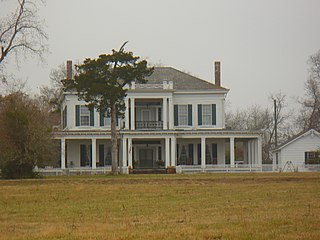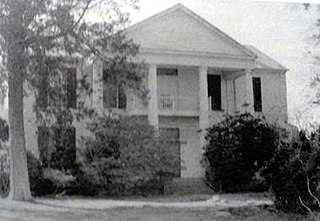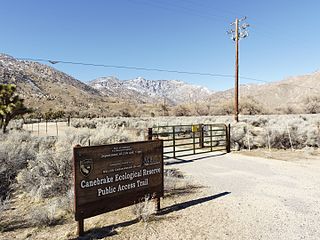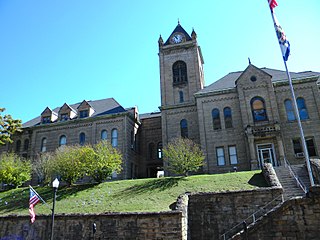A canebrake is a thick, dense growth of cane or sugarcane.
Samuel M. Lambert was an American labor leader who served as executive secretary of the National Education Association during the administration of Richard M. Nixon. Because of the political power wielded by the group, and because of their opposition of federal funding for parochial schools, Lambert was placed on Nixon's Enemies List.

The Dry Fork is a 47.7-mile-long (76.8 km) tributary of the Tug Fork, belonging to the Ohio River watershed. The river is located in McDowell County, West Virginia, and Tazewell County, Virginia, in the United States. The mouth of the Dry Fork into the Tug Fork is located at Iaeger.

Cedar Grove Plantation, also known as the Charles Walker House, is a Greek Revival plantation house located near Faunsdale, Marengo County, Alabama. It is notable in having been the residence of Nicola Marschall for a brief period while the Walker family owned the property. The house was added to the National Register of Historic Places on 13 July 1993 as a part of the Plantation Houses of the Alabama Canebrake and Their Associated Outbuildings Multiple Property Submission.

Faunsdale Plantation is a historic plantation near Faunsdale, Alabama, United States. The slave quarters on the property are among the most significant examples of slave housing in Marengo County and are among the last remaining examples in the state of Alabama. The house was added to the National Register of Historic Places on 13 July 1993 as a part of the Plantation Houses of the Alabama Canebrake and Their Associated Outbuildings Multiple Property Submission.

The Plantation Houses of the Alabama Canebrake and Their Associated Outbuildings Multiple Property Submission is a multiple property submission of properties that were together listed on the National Register of Historic Places. The multiple property submission covers plantation properties that are within the Alabama Canebrake. The National Park Service has determined that all are historically or architecturally significant as a surviving group of plantation structures in what was once one of the wealthiest areas of the state.

Northwest River Natural Area Preserve is a 2,774-acre (11.23 km2) Natural Area Preserve located in the city of Chesapeake, Virginia. Located along the Northwest River, the preserve protects upland forests as well as swamps and marshes along the river.

Cavalier Wildlife Management Area is a 4,550-acre (18.4 km2) Wildlife Management Area in Chesapeake, Virginia. It preserves habitat for a number of species, including black bear, canebrake rattlesnakes, white-tailed deer, eastern wild turkeys, and many varieties of songbirds.

Cedar Crest, also known as Cedar Crest Farms, is a Greek Revival plantation house located near Faunsdale, Alabama. It was built for Kimbrough Cassels Dubose in 1850 by Albert Prince, a slave. Dubose, born in Darlington District, South Carolina was educated at the preparatory school of Prof. Stafford who later was of the faculty of the University of Alabama. His wife was Miss Elizabeth Boykin Witherspoon also of Darlington District, South Carolina, and they had seven sons and four daughters: John Witherspoon, James Henry, Jr., Eugene, Nicholas William, Francis Marion, Lemuel Benton and Edwin Dargan-the daughters Louisa, Rosalie, Augusta and Adele. The house is one-and-a-half stories with side gables, but has been simplified. It originally had side wings, with adjoining porches across the front. These were removed in 1939, leaving the small central front portico. Another historic plantation house, Altwood, was moved from a nearby location to the Cedar Crest grounds in 1988. The house was added to the National Register of Historic Places on August 5, 1993 as a part of the Plantation Houses of the Alabama Canebrake and Their Associated Outbuildings Multiple Property Submission.

Altwood is a historic plantation house located near Faunsdale, Alabama. It was built in 1836 by Richard H. Adams and began as a log dogtrot house. It was then expanded until it came to superficially resemble a Tidewater-type cottage. Brought to the early Alabama frontier by settlers from the Tidewater and Piedmont regions of Virginia, this vernacular house-type is usually a story-and-a-half in height, displays strict symmetry, and is characterized by prominent end chimneys flanking a steeply pitched longitudinal gable roof that is often pierced by dormer windows.

Cedar Haven was a historic Greek Revival plantation house located near Faunsdale, Alabama. It was built in 1850 by Phillip J. Weaver. Weaver was a prominent merchant and planter. He was born in Mifflintown, Pennsylvania in 1797 and relocated to Selma from Uniontown, Maryland in 1818. He ran a very successful store in Selma and also maintained a home there.

Battersea is a historic plantation house in Prairieville, Alabama. The house was built from 1820-45 by the Vaughan family from Petersburg, Virginia and served as an early stagecoach stop. It was added to the National Register of Historic Places as a historic district on July 7, 1994 as a part of the Plantation Houses of the Alabama Canebrake and Their Associated Outbuildings Multiple Property Submission.
The Canebrake refers to a historical region of west-central Alabama that was once dominated by thickets of Arundinaria, a type of bamboo, or cane, native to North America. It was centered on the junction of the Tombigbee and Black Warrior rivers, near Demopolis, and extended eastward to include large parts of Hale, Marengo, and Perry counties. Portions of Greene and Sumter were also often included.

Hawthorne, also known as the Browder Place and Davis House, is a historic Italianate plantation house and historic district in Prairieville, Alabama, USA. This area of Hale County was included in Marengo County before the creation of Hale in 1867. Hawthorne is included in the Plantation Houses of the Alabama Canebrake and Their Associated Outbuildings Multiple Property Submission. It was added to the National Register of Historic Places on July 7, 1994, due to its architectural significance.

Canebrake is an unincorporated community in Kern County, California. It is located along California State Route 178 in the South Fork Valley, 5.3 miles (9 km) east-northeast of Onyx at an elevation of 3,031 feet (924 m).

Canebrake is a former settlement in Kern County, California. It was located 5.5 miles (8.9 km) north-northwest of Walker Pass, along Canebrake Creek at an elevation of 3930 feet.
Cane are very tall perennial grasses, with flexible stalks, that grow in damp soils.

Canebrake Ecological Reserve is a 6,700-acre (27 km2) nature reserve in the South Fork Valley of Kern County, 20 miles (32 km) east of Lake Isabella, California. It is located in the Southern Sierra Nevada region.

Henry Augustine Tayloe was an American planter, horse breeder and land speculator during the 19th century. He was in part named for his uncle, Capt William Augustine Washington, son of Augustine Washington Jr. and Anne Aylett, nephew of George Washington. He founded the Fair Grounds Race Course in 1838 with Bernard de Marigny, pioneered cotton planting in the Canebrake and built St. Andrew's Episcopal Church. He was the youngest son of John Tayloe III and served as his brother's agents in the Canebrake later founding Faunsdale, Alabama.

Canebrake is a historic plantation house in Ferriday, Louisiana. The house was located inside a 531 acres (215 ha) plantation west of Mississippi River and east of Lake St. John.




















